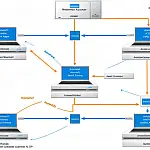Versioning Your C# REST API: Best Practices and ApproachesThis detailed article will show you the best practises and methodologies for versioning your C# REST API. Master API versioning and ensure your users have a smooth transition.
This article is part of a series of articles. Please use the links below to navigate between the articles.
- A Beginner's Guide to Building a REST API in C#
- Using Swagger to Document and Test Your C# REST API
- How to Add Authentication and Authorization to C# REST APIs
- Error Handling and Exception Management in C# REST APIs
- Data Validation and Error Handling in REST APIs using C#
- Versioning Your C# REST API: Best Practices and Approaches
- Caching Strategies for Improved Efficiency in C# REST APIs
- How to Implement Rate Limiting in Your C# REST API
Versioning your C# REST API is an essential requirement for preserving compatibility and providing a positive user experience. In this detailed article, we will look at the best practices and methodologies for versioning your API in C#, allowing you to handle changes and updates effectively while minimising interruptions for your users. This article will provide you with the information and tools you need to understand API versioning in C#, whether you are a novice or an experienced developer.
Understand the Importance of API Versioning
API versioning is crucial for maintaining compatibility and ensuring a smooth experience for your users. As your API evolves and new features are added, it is important to have a system in place that allows for backward compatibility. This means that older versions of your API can still be used by existing clients, while newer versions can be adopted by clients who want to take advantage of the latest features. Without proper versioning, making changes to your API can result in breaking changes for your users, leading to frustration and potential disruptions in their workflows. By understanding the importance of API versioning and implementing best practices, you can ensure a seamless transition for your users and maintain a positive user experience.
Choose a Versioning Strategy That Suits Your Project
When it comes to API versioning in C#, there are many options to consider. The best technique for your project will be determined by criteria such as the complexity of your API, the number of clients who will use it, and the level of control you desire over the versioning process.
One popular method is URL-based versioning, in which the version number is incorporated in the URL of the API endpoint. This enables clear separation between versions and ensures that clients can continue to use previous versions if necessary.
Another method is to employ header-based versioning, which includes the version number in the request headers. This is useful if you wish to maintain the URL structure consistent across multiple API versions.
Consider employing media type versioning, in which the version number is incorporated in the response's media type. This technique gives you additional versioning freedom because you can have distinct versions of the same resource with different media formats.
The versioning approach you use will be determined by your individual project objectives and preferences. It is critical to thoroughly analyse the advantages and disadvantages of each strategy and select the one that best meets your needs.
Implement versioning in your C# REST API
Implementing versioning in your C# REST API is crucial for ensuring smooth transitions for your users and maintaining control over the versioning process. There are several strategies you can choose from, including URL-based versioning, header-based versioning, and media-type versioning.
How To Use URI Versioning in C# REST API
URL-based versioning involves including the version number in the URL of the API endpoint. This allows for easy differentiation between different versions and ensures that clients can continue using older versions if needed. This is a straightforward approach and is often used. Here's how to do it in a C# REST API:
Install the Microsoft.AspNetCore.Mvc.Versioning NuGet Package:
dotnet add package Microsoft.AspNetCore.Mvc.Versioning
Configure API versioning in your Startup.cs, configure API versioning using the AddApiVersioning method:
using Microsoft.AspNetCore.Mvc;
public void ConfigureServices(IServiceCollection services)
{
services.AddApiVersioning(options =>
{
options.DefaultApiVersion = new ApiVersion(1, 0);
options.AssumeDefaultVersionWhenUnspecified = true;
options.ReportApiVersions = true;
});
/ Other service configurations...
} In your API controllers, use the [ApiVersion] attribute to specify the version:
[ApiVersion("1.0")]
[Route("api/v{version:apiVersion}/[controller]")]
public class MyController : ControllerBase
{
/ Controller actions
} How To Use HTTP Header Versioning in C# REST API
In HTTP header versioning, the API version is specified in an HTTP header. This approach keeps URIs clean and separates versioning from the URI. Here's how to do it:
Install the Microsoft.AspNetCore.Mvc.Versioning NuGet Package (if not already installed).
dotnet add package Microsoft.AspNetCore.Mvc.Versioning
Configure API versioning in your Startup.cs
using Microsoft.AspNetCore.Mvc;
public void ConfigureServices(IServiceCollection services)
{
services.AddApiVersioning(options =>
{
options.DefaultApiVersion = new ApiVersion(1, 0);
options.AssumeDefaultVersionWhenUnspecified = true;
options.ReportApiVersions = true;
});
/ Other service configurations...
} In your API controllers, use the [ApiVersion] attribute to specify the version. For HTTP header versioning, no need to include the version in the route.
[ApiVersion("1.0")]
[Route("api/[controller]")]
public class MyController : ControllerBase
{
/ Controller actions
} In your client requests, include the Api-Version header to specify the API version. For example, in a request made with a tool like Postman, you can set the Api-Version header to 1.0.
How To Use Media Type Versioning in C# REST API
Media type versioning, also known as content negotiation, is a technique used in REST APIs to enable various API versions by stating the version in the HTTP request's 'Accept' header. Clients can request a specific API version, which is useful for maintaining backward compatibility while providing new functionality. In this example, we'll use the `Accept` header to specify the version.
To support media type versioning, utilise the Produces element in your controllers to indicate the response's media type. In this example, the Accept header would be used to define the desired media type, which includes the API version.
[ApiController]
[Route("api/[controller]")]
public class MyController : ControllerBase
{
[HttpGet]
[Produces("application/json;v=1.0")]
public IActionResult GetV1()
{
/ Your version 1.0 API logic here
return Ok(new { version = "1.0", message = "Version 1.0 response" });
}
[HttpGet]
[Produces("application/json;v=2.0")]
public IActionResult GetV2()
{
/ Your version 2.0 API logic here
return Ok(new { version = "2.0", message = "Version 2.0 response" });
}
} In this example, two versions of the Get endpoint are supplied, each of which produces a different media type depending on the version specified in the Accept header. In the Produces attribute, the version is supplied as a parameter following the semicolon.
When making requests, clients can specify the desired version in the Accept header. A client requesting version 2.0 of the API, for example, would set the Accept header as follows:
Accept: application/json;v=2.0
When the request is made, the server will return the response based on the specified version.
Communicate Version Changes Effectively to Users
It is vital to effectively communicate version changes to your consumers when implementing versioning in your C# REST API. This ensures that they are aware of any API updates or changes and can make the required changes on their end.
Clear and succinct documentation is one efficient technique to communicate version changes. Give specifics on the changes made in each version, such as new features, deprecated endpoints, or breaking changes. This allows users to quickly understand what has changed and how it may affect their API integration.
Consider establishing an easy-to-understand and follow versioning strategy as well. To identify the relevance of each version change, use semantic versioning, such as MAJOR.MINOR.PATCH. This allows users to rapidly determine whether a version update has significant changes that necessitate additional attention and testing.
Think about providing a migration guide or upgrade path for users who are upgrading from one version to another. This can include step-by-step instructions, code examples, and any configuration modifications that are required. You may reduce disruptions and confusion for your users during the transition process by offering clear information.
Handle Backward Compatibility and Deprecations
It is important to handle backward compatibility and deprecation correctly when implementing versioning in your C# REST API. Backward compatibility refers to the ability of newer API versions to seamlessly interact with older versions, ensuring that existing integrations and applications continue to perform as expected.
To ensure backward compatibility, any updates or adjustments to the API must be carefully planned and tested. Consider the impact of any breaking changes on existing integrations before making them, and explain any changes to your users in advance. This gives them time to plan and make any required revisions.









